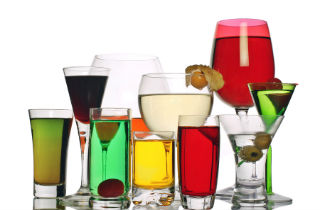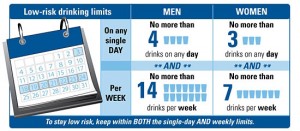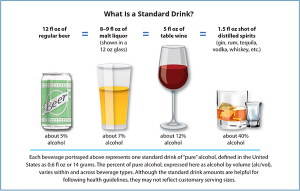ARTICLE SUMMARY: Alcoholism the #1 addiction in America. The social acceptance of drinking can often lead to denial. But if left untreated, a drinking problem has severe consequences.
ESTIMATED READING TIME: 5-10 minutes.
TABLE OF CONTENTS:
- No Healthy Amount
- Abuse Definitions
- Beer
- Wine
- Liquor
- Binge Drinking
- Mixing Alcohol with Drugs
- When It Becomes Addiction
- High-Functioning Alcoholism
- Statistics
- When to Get Help
New studies reveal that NO LEVEL OF ALCOHOL CONSUMPTION improves health. In other words, alcohol is not good for you.
No Healthy Amount
Most people drink for one of two reasons:
1. People drink alcohol to cope with stress.
2. People drink alcohol because of social influences.
Indeed, alcohol is socially acceptable. Most of us drink it in various forms, including beer, wine, and hard liquor. And many of us think that there are health benefits associated with consuming up to two drinks per day. However, recent studies are finding that no level of alcohol consumption improves health. So, a drinking problem can occur… even if you think you’re drinking within reasonable limits.
“Abuse” Definitions
According to the Dietary Guidelines for Americans,1 moderate alcohol consumption is defined as having up to 1 drink per day for women and up to 2 drinks per day for men. However, the Dietary Guidelines do not recommend that people who do not drink alcohol start drinking for any reason. This is simply because alcohol is not good for you!
Not everyone who drinks is an alcoholic. In fact, about half of all Americans are active drinkers. But if your life is negatively affected by alcohol on a consistent basis, you may have a problem.
So, what does it mean to “abuse” alcohol? The National Institute on Alcohol Abuse and Alcoholism (NIAAA) has a website Rethinking Drinking that defines what problem drinking is. And it’s not based on how much you drink, exactly. They say,”
The more drinks you drink on any day and the more heavy drinking days over time, the greater the risk—not only for an alcohol use disorder, but also for other health and personal problems.
Still, you can begin to suspect a drinking problem when…
Men: You drink more than 4 drinks on any day OR you drink more than 14 drinks per week.
Women: You drink more than 3 drinks on any day OR you drink more than 7 drinks per week.
Image credit: NIAAA Rethinking Drinking
So, if you are drinking like this, are you an alcoholic? According to the NIAAA, about 1 in 4 people who exceed these limits already has an alcohol use disorder (also called “alcoholism”). The remaining 3 in 4 people are at greater risk for developing these and other problems. Again, individual risks vary. People can have problems drinking less than these amounts, particularly if they drink too quickly.
Use this NIAAA form to verify a drinking problem.
DRINKING TOO MUCH + TOO OFTEN = TOO RISKY
Definitions of a standard drink:
Beer
Beer is an alcoholic drink typically made from water, barley, hops, and yeast. Many people think that beer is safer to drink than wine or liquor. The Centers for Disease Control (CDC) describes the real story about beer on this alcohol FAQ page:
Q: Is beer or wine safer to drink than liquor?
A: No. One 12-ounce beer has about the same amount of alcohol as one 5-ounce glass of wine or 1.5-ounce shot of liquor.
In fact, one beer may be your limit for the night, if you’re a man…and half a beer may be all you need if you’re a woman. It is the amount of alcohol consumed that affects a person most, not the type of alcoholic drink.
But beer is a part of American culture. It can be hard to ignore the billboards and advertising around beer. There are drinking games based on beer, sporting events usually always have beer available, and beer is a part of post-work get together. Plus, the trend for microbrewed, craft beers is on the rise. However, even people who drink during social activities or who only drink craft beer can develop an alcohol use disorder.
So, how do you know if you’re addicted to beer, or not?
Signs of a problem may include continuing to drink when everyone else has stopped or feeling the need to drink during uncomfortable or boring situations. Basically, a drinking problem causes disruption in your life. So, if you’re facing beer addiction you may have difficulty making it to work on time, keeping up with schoolwork, or recovering from drinking the next day. To get help for a beer addiction now, please send us a message or give us a call.
Wine
Wine is made from fermented grapes. It is mostly sold as white wine or red wine with a variety of flavor profiles based on the type of grape used. For example, popular white wines include Sauvignon Blanc, Chardonnay, Pinot Grigio, and Riesling. Popular red wines include Cabernet Sauvignon, Merlot, Pinot Noir and Syrah / Shiraz.
The percentage of alcohol in wine can vary widely; therefore, read the labels and adjust accordingly. When compared to beer, wine has a more concentrated amount of alcohol. Still, an average 5 oz. glass of wine is equivalent in alcohol content to 12 oz. of beer. An overpoured glass of wine, however, could contain much more alcohol than a standard drink.
Wine is often consumed with meals. It has a status as a “classy” drink that can make it harder to spot a problem. Drinking wine may be a problem for you if any of these things are true:
- Drinking wine causes trouble with your relationships, school, or work.
- You can’t control how much wine you drink.
- You’ve tried quitting drinking but cannot.
- You feel anxious, irritable, or stressed when you aren’t drinking wine.
If you or someone you care about has been drinking wine more frequently than intended or using it to combat anxious or depressive feelings, there may be a deeper issue at play. The earlier you get help for a wine addiction, the better! Wine problems are medical in nature and can be treated professionally.
Liquor
“Liquor” is the term used for hard alcoholic drinks or spirits like tequila, vodka, gin, rum and whiskey. Liquor has a much higher volume of alcohol than beer or wine: approximately 1.5 ounces of distilled spirits contain about 40% alcohol. Additionally, the type of spirit, recipe, and size of serving glass can impact the quantity of hard liquor in the drink. A mixed drink can contain from one to three or more standard drinks.
Liquor can impact and speed up the development of a drinking problem. This is due to the way we metabolize alcohol. The Indian Health Service explains it like this…when a person drinks an alcoholic beverage, about 20% of the alcohol is absorbed in the stomach and about 80% is absorbed in the small intestine. The rate the alcohol is absorbed depends upon a few factors:
1. The higher the concentration of alcohol, the faster the absorption.
2. Carbonated drinks tend to speed up absorption of alcohol.
3. Whether the stomach is full or empty. Food can slow down alcohol absorption.
Basically, increased absorption of alcohol into the bloodstream can cause quicker intoxication. It’s like comparing oral vs. injection routes of drug administration. The quicker a drug hits your bloodstream and crosses the blood-brain barrier, the more addictive. Plus, the lower liquid content of shots make them easier to consume, leading to a higher risk of alcoholism.
Regardless of the type of liquor consumed, alcohol of any kind possesses serious addiction potential. But you can get help for a liquor addiction now. Continue reading for more ideas.
Binge Drinking
Drinking too much at once is called “binge drinking”. As noted by the CDC, it is the most common way people drink too much in the U.S. But what does it mean to binge drink?
The National Institute on Alcohol Abuse and Alcoholism defines binge drinking as a pattern of drinking that brings a person’s blood alcohol concentration (BAC) to 0.08 grams percent or above. Guidelines follow.
Men: You binge drink when you consume 5 or more drinks on a single occasion and usually occurs within about 2 hours.
Women: You binge drink when you consume 4 or more drinks on a single occasion and usually occurs within about 2 hours.
While most people who binge drink are not alcohol dependent, binge drinking is the most common, costly, and deadly pattern of drinking too much. It causes injury and serious risk to health. It occurs frequently, with one in six adults binging about four times a month. And in many cases, prolonged binge drinking can develop into alcoholism.
Mixing Alcohol with Drugs
Because drinking is easily accessible, people often mix alcohol with other drugs. However, alcohol is both a central nervous depressant AND a stimulant… thereby posing a serious risk to your health when you mix it. For example, when mixed with benzodiazepines, opiates, or Rx painkillers, alcohol can trigger overdose effects. Alcohol on its own can be dangerous, but combining it with other substances can quickly prove lethal.
When It Becomes Addiction
Addiction occurs somewhere in a person’s drinking history. It can happen fast, within the span of a few months. Or, addiction can occur over the course of years. So when do you know you’ve crossed the line and become addicted to alcohol?
Alcoholism (a.k.a. alcohol addiction) is marked by a craving for alcohol. This craving occurs after the first drink and compels you to drink more. Craving also occurs when you’re NOT drinking; it can drive you back to alcohol. People who are addicted also are unable to stop drinking, especially in the face of personal or social harm.
Signs of an alcohol addiction include:
- Alcohol dependence.
- An increased tolerance (needing to drink more to feel drunk).
- Frequently drinking more than intended.
- Spending time getting alcohol, drinking it, or recovering from its effects.
- Wanting to stop drinking but being unable to.
High-Functioning Alcoholism
Not all alcoholics are bottom of the bottle drinkers.
In the early 2000’s researchers officially recognized a subset of drinkers called “high-functioning” alcoholics. Study author Howard B. Moss, M.D., NIAAA Associate Director for Clinical and Translational Research said, “We find that young adults comprise the largest group of alcoholics in this country, and nearly 20 percent of alcoholics are highly functional and well-educated with good incomes.”
The problem with high-functioning alcoholism is that it can go undiagnosed. As people are able to keep their jobs, and experience relatively few harms…they often do not seek help. If you think you might have a drinking problem, ask for help. Here are some suggestions that we have for you:
- Ask your friends and loved ones to support you.
- Talk to a doctor or nurse if you are having a hard time cutting down on your drinking.
- If one type of treatment doesn’t work for you, you can try another. Don’t give up!
- Call 1-800-662-HELP (1-800-662-4357) for information about treatment.
- To explore treatment options, visit the NIAAA Treatment Navigator.
Statistics
Alcohol use is a leading risk factor for disease burden worldwide, accounting for nearly 10% of global deaths among populations aged 15–49 years, according to the 2016 Global Burden of Diseases report. This 2011 study breaks down the most common disease categories that are entirely or partly caused by alcohol consumption, which can include:
- Cancer
- Cardiovascular disease
- Diabetes
- Infectious diseases
- Liver and pancreas disease
- Neuropsychiatric diseases (including alcohol use disorders)
- Unintentional and intentional injury
Why wait for things to get worse?
Reach out and get help today.
When to Get Help
Getting help for a drinking problem early is best!
So, if you think that you have a problem with alcohol, it’s best to assume that you do.
Then, reach out for help.
You are not alone!
Many people who struggle with alcohol addiction find it difficult or impossible to quit on their own. There are many programs designed to get you the help you need. Or, you can increase your chance of a full recovery with the help of an alcohol rehab center. Get in touch with one today….and increase your chances for success and an alcohol-free life!











Related Posts